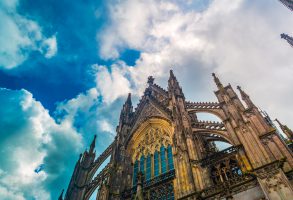Published April 19, 2011
Avvenire
“A catechist who knows how to speak to the heart and to the mind and a vigorous defender of religious freedom.”
Intellectual and spiritual continuity with his predecessor: this is what George Weigel—one of the principal American theologians, and author of both the best-selling biography of John Paul II, Witness to Hope, and God’s Choice, on Joseph Ratzinger’s election to the papacy—sees in the first six years of Benedict XVI’s pontificate. But also the revelation to the world of an authentic teacher who knows how to put before Catholics the challenges of the moment.
What have been the main priorities of Benedict’s pontificate so far?
He has been a marvelous catechist of the basics of the Faith, in his homilies and during his pastoral pilgrimages abroad. Through his Wednesday audiences, he has reminded the Church of the riches of its theological heritage, which is important in an age that is characterized by “presentism” and a lack of rootedness in the intellectual life. He has tried to teach the Church something about the beauty of the liturgy, and about the proper orientation of the liturgy toward the worship of the Triune God. And he has voiced a determination to rid the Church, the priesthood, and the episcopate of corruption, especially in terms of sexual abuse.
In his engagement with the world, Benedict XVI has been a vigorous defender of religious freedom in a season of intolerance, and he has tried, although without much success, to re-orient the Catholic-Muslim dialogue to the real questions of the moment, which involve religious freedom and the separation of religious and political authority in the 21st century state.
What is Benedict’s style of pastoral care?
I think it was well-displayed in the United States and Great Britain, where he met, prayed, and wept with abuse victims. I’d also describe his catechetical method as a “style of pastoral care:” the Pope knows that the mind, as well as the heart and soul, needs to be fed, and he is a master teacher who can distill the essence of Christian truth, even at its most complex, into terms that everyone can grasp and appreciate.
What has Pope Benedict’s descripion of a “friendship” between faith and science done to heal the perceived separation between men of science and men of faith?
It has continued the healing begun by Ven. John Paul II. The problem now is that the chasm between the Church and science is not with the “hard sciences” (physics, astronomy, etc.) but with the life sciences—biology, genetics, and so forth. There, the Promethean temptation to reconfigure the human condition by manufacturing or remanufacturing human beings is rampant. And that is a problem in the order of metaphysics and morals, neither of which is a well-developed or much appreciated partner in the world of the 21st century life sciences.
During his first homily in the cathedral of Rome, Pope Ratzinger emphasized the inviolability of human life from the time of conception. Why do you think he felt such as a sense of urgency? Has this urgency characterized his papacy?
It is one example of this pontificate’s dynamic continuity with its predecessor. Europe is dying from self-induced infertility. Abortion is considered a “solution” to serious human problems throughout the world, and in some cases, like China, is a state-mandated method of population control. The elderly are considered as another “problem” to be solved (usually according to utilitarian criteria), not as people to be cherished. Of course the Pope has to speak about these matters from the one pulpit that commands the world’s attention.
At the time of his elevation, many commentators questioned Ratzinger’s ability to give to his papacy the same “human touch” and warmth as his predecessor. What have these six years shown about his “humanity”?
It’s shown me, and others who were privileged to know him before his election as pope, that he can communicate on a public stage what we had always known: that he is a man of graceful manners, real compassion, and priestly charity.
What are the main elements of continuity between John Paul II and Benedict XVI?
These two pontificates are bringing to a high point of development, even as they bring to a close, a period in the Church’s history that began with Leo XIII and reached one crucial moment of development at Vatican II, to which the pontificates of John Paul II and Benedict XVI have offered an authoritative interpretation. The challenge they have both put before the Church—which is the challenge of this entire line of development since Leo XIII—is to become a Church of what I call “evangelical Catholicism”: a Church that is a mission, a Church in which everything and everyone is measured by their contributions to an evangelization of “the deep” of the 21st century, as John Paul II put it in Novo Millennio Ineunte.
[The following question was posed, with the answer following given; but the exchange was not printed for reasons of space]
Has Pope Benedict’s renewed attention to persecuted and embattled Christians helped or hindered the dialogue with other faiths?
Dialogue is difficult, if not impossible, when the dialogue partner’s followers are murdering Christians. The defense of religious freedom, and of persecuted Christians, is a grave responsibility of the Church’s leaders. And the evidence of history is that, when the Church is vigorously defended, the Church is less susceptible to attack.
George Weigel is Distinguished Senior Fellow and William E. Simon Chair in Catholic Studies at the Ethics and Public Policy Center in Washington, D.C.






